Why Your Air Rifle Accuracy is Declining: 7 Hidden Causes Most Shooters Miss
You’ve cleaned your barrel, checked your scope, and your technique is solid – yet your groups are getting wider. Here’s what expert gunsmiths know about hidden accuracy killers.
If you’re an experienced air rifle enthusiast, you’ll know the frustration of watching your precision gradually deteriorate despite following a regular maintenance routine. You’ve done everything by the book: cleaned the barrel religiously, ensured your scope mounts are tight, and your shooting fundamentals remain consistent. Yet somehow, those tight groups that once brought pride to your shooting sessions are slowly opening up.
The truth is, subtle maintenance issues can cause progressive accuracy decline that’s often mistaken for shooter error or simple bad luck. Whilst most shooters focus on the obvious culprits – dirty barrels or loose scopes – professional gunsmiths understand that the real accuracy killers are often hidden within your rifle’s mechanical systems, silently degrading performance over months or even years.
This comprehensive air rifle maintenance guide will reveal seven often-overlooked causes of accuracy decline that even experienced shooters frequently miss. We’ll examine the subtle mechanical issues that affect precision, provide expert diagnostic techniques used by professionals, and deliver proven solutions to restore your rifle’s peak performance. By understanding these hidden accuracy robbers, you’ll develop the advanced maintenance skills needed to keep your air rifle performing at competition level for years to come.
The Silent Accuracy Killers
The most insidious air rifle accuracy problems develop gradually, making them difficult to detect until they’ve significantly impacted your shooting performance. Unlike catastrophic failures that announce themselves with dramatic symptoms, these silent accuracy killers work progressively, often mimicking other issues or being dismissed as normal wear. Understanding these subtle mechanical degradations is crucial for maintaining precision shooting standards.
1. Breech Seal Degradation
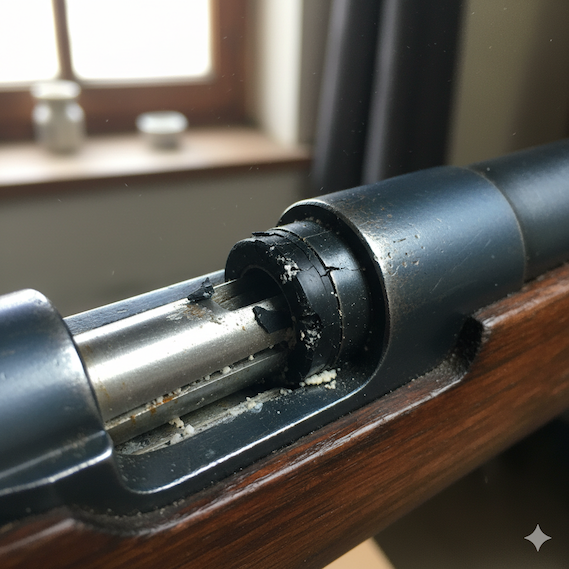
Your rifle’s breech seal represents one of the most critical yet overlooked components affecting accuracy. This seemingly simple rubber or synthetic seal sits between the breech and the chamber, ensuring consistent air pressure behind each pellet. When functioning properly, it’s invisible to your shooting experience. When failing, it becomes a major accuracy destroyer.
The signs of worn breech seals are subtle but detectable if you know what to look for. A slight decrease in velocity consistency often appears first – your chronograph readings might show a standard deviation that’s gradually increased from 5 fps to 15 fps over several months. You might notice that your rifle requires slightly more force to cock, or that the loading process feels different. Some shooters report a barely perceptible “puff” of air during cocking, indicating seal leakage.
The impact on velocity consistency directly translates to accuracy problems. Even small variations in muzzle velocity create different trajectory curves, causing vertical stringing in your groups. A degraded breech seal can cause velocity variations of 20-50 fps, which at 30 yards might open your groups from sub-inch to 2-3 inches.
Testing for seal issues requires systematic chronograph work. Record 20-shot strings over several sessions, noting the extreme spread and standard deviation. If your rifle previously maintained single-digit standard deviations but now shows consistently higher variations, breech seal degradation should be your prime suspect. Visual inspection during disassembly often reveals cracking, hardening, or visible wear on the seal edges.
2. Spring Fatigue Symptoms
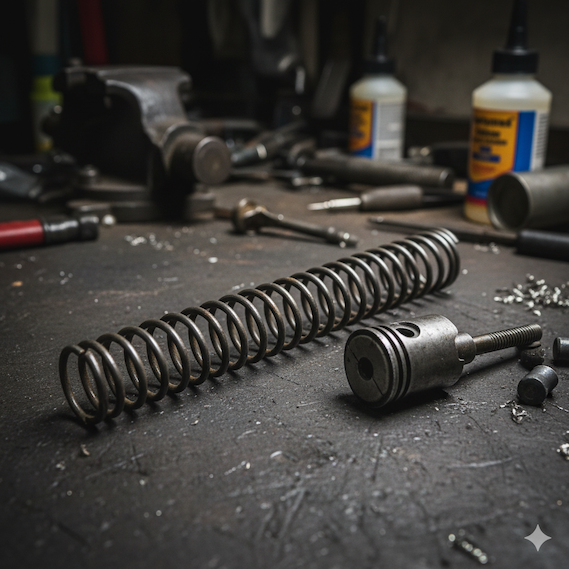
Spring-powered air rifles depend on precise spring compression and release cycles to achieve consistent performance. Unlike coil springs in automotive applications that fail dramatically, airgun mainsprings exhibit fatigue symptoms that develop slowly and often go unrecognised by shooters.
Early warning signs of spring wear include subtle changes in the cocking effort required, though this can be difficult to detect without reference points. More obvious indicators include increased vibration during firing, changes in the rifle’s sound signature, or a slightly different “feel” to the shot cycle. Experienced shooters often describe a spring-powered rifle as feeling “tired” or lacking the crisp snap of a healthy powerplant.
How spring fatigue affects shot consistency extends beyond simple power reduction. A fatiguing spring loses its ability to deliver repeatable compression cycles, creating variations in the energy transferred to each pellet. This manifests as velocity inconsistencies similar to breech seal problems but often combined with changes in the rifle’s balance point and recoil characteristics.
Measuring spring performance requires careful chronograph analysis over extended shooting sessions. A healthy spring should deliver consistent velocities throughout a 50-shot session with minimal variation. Springs showing fatigue often demonstrate increasing velocity scatter as they warm up, or may show power curves that differ significantly from the rifle’s original specifications. Professional gunsmiths often measure spring compression length and compare it to factory specifications, though this requires complete disassembly.
3. Crown Damage and Bore Inconsistencies
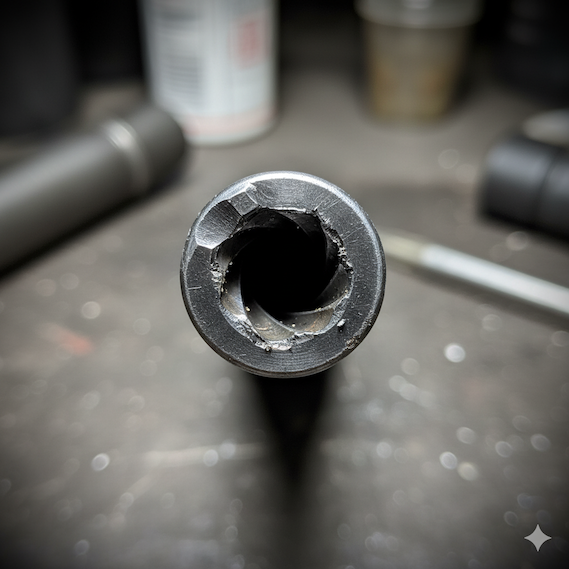
The muzzle crown represents the last point of contact between your pellet and the rifle, making it critical for accuracy. Even microscopic imperfections can cause gas turbulence that deflects pellets from their intended trajectory. Crown damage often occurs gradually through normal cleaning procedures, making it particularly insidious.
Cleaning rod damage represents the most common source of crown problems. Repeated insertion of cleaning rods, especially steel or brass varieties, can create tiny nicks or wear patterns that disrupt gas flow. Even careful cleaning can cause damage if the rod contacts the crown repeatedly in the same spot. Carbon fibre or coated cleaning rods reduce this risk but don’t eliminate it entirely.
Visual inspection techniques for crown assessment require good lighting and magnification. A quality jeweller’s loupe or small inspection scope reveals imperfections invisible to the naked eye. Look for nicks, scratches, or uneven wear patterns around the crown’s edge. Professional gunsmiths often use specialised crown gauges that detect variations measured in thousandths of an inch.
Bore condition assessment extends beyond simple cleanliness checks. Lead fouling can build up gradually, creating inconsistencies that affect pellet engagement and exit velocity. More concerning are wear patterns that develop from consistent use of hard pellets or inadequate lubrication. These create variations in barrel dimensions that manifest as accuracy problems.
Advanced Diagnostic Techniques
Professional air rifle troubleshooting goes far beyond basic maintenance checks, employing systematic diagnostic methods that reveal problems invisible to casual inspection. These techniques, used by competition gunsmiths and manufacturers, can identify accuracy-robbing issues before they become severe enough to obviously impact performance.
4. Stock Pressure Points and Bedding Issues
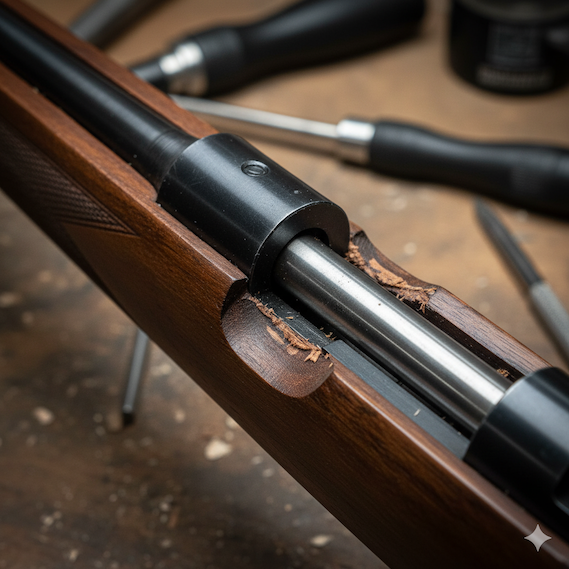
The relationship between your rifle’s action and stock creates a crucial foundation for accuracy, yet stock pressure points remain one of the most misunderstood aspects of air rifle maintenance. Unlike firearms that generate significant recoil forces, air rifles create complex vibration patterns that can be dramatically affected by improper stock contact.
Identifying stock contact issues requires understanding how your specific rifle design should interface with its stock. Traditional spring-piston rifles often benefit from contact at the action’s front and rear, creating a stable platform. However, PCP rifles might require completely free-floating barrels with minimal stock contact. The challenge lies in detecting when these contact points have shifted due to wood movement, metal expansion, or simple settling over time.
Testing for proper bedding involves several techniques used by professional gunsmiths. The “dollar bill test” involves sliding currency along the barrel channel – proper clearance should allow smooth movement without binding or excessive gaps. More precise methods include using feeler gauges to measure specific clearances and marking high spots with engineer’s blue or similar indicating compounds.
Environmental factors significantly impact stock-to-action fit. Wooden stocks expand and contract with humidity changes, potentially creating pressure points that weren’t present when the rifle was properly bedded. Temperature variations can also cause differential expansion between wood and metal components, altering the stress patterns within the stock assembly.
Fixing stock pressure problems often requires careful material removal using hand tools and patience. Professional stock work might involve bedding compounds to create perfect contact surfaces, but many accuracy improvements can be achieved through careful sanding and fitting. The key principle involves creating consistent, repeatable contact that doesn’t vary with temperature, humidity, or minor impacts.
5. Trigger Mechanism Deterioration
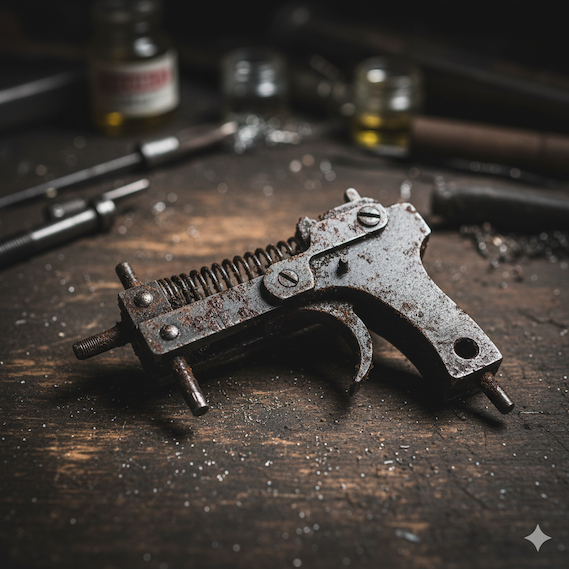
Your trigger mechanism represents the final link in the accuracy chain, yet trigger problems often develop so gradually that shooters unconsciously adapt their technique to compensate for degrading performance. Professional trigger assessment reveals issues that directly impact shooting precision.
Trigger creep detection requires sensitivity to subtle changes in trigger feel and performance. A proper trigger should break cleanly with minimal overtravel and return to battery with consistent tension. Creep develops when sear surfaces wear unevenly, creating increasingly unpredictable release points. This forces shooters to apply varying pressures, introducing human error into the shooting equation.
Contamination represents another major trigger problem that develops progressively. Dust, moisture, and lubricant residues can accumulate in trigger mechanisms, creating inconsistent engagement and release characteristics. Unlike obvious contamination that prevents proper function, subtle buildup simply makes the trigger less predictable without completely disabling it.
Sear engagement testing involves careful measurement of trigger pull weights and consistency across multiple actuations. Professional gunsmiths use specialised gauges to measure pull weights to fractions of an ounce, looking for variations that indicate wear or contamination. Visual inspection of sear surfaces during cleaning often reveals polishing patterns that indicate proper or improper engagement.
Creating a maintenance schedule for trigger mechanisms depends on usage patterns and environmental conditions. Competition rifles seeing frequent use might require detailed trigger cleaning every 2,000 shots, whilst hunting rifles used occasionally might only need annual attention. The key involves establishing baseline measurements and monitoring for changes over time.
6. Scope Mount Integrity and Optical Issues
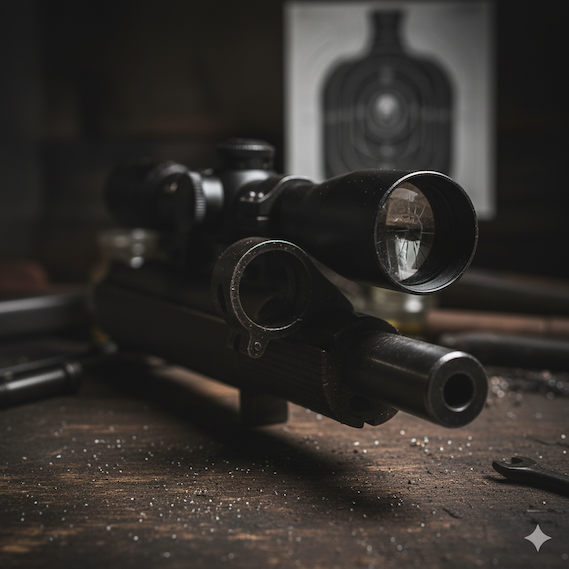
Scope mounting problems represent some of the most frustrating accuracy issues because they can mimic rifle mechanical problems whilst being completely unrelated to the air rifle itself. Professional scope diagnostics reveal mounting and optical problems that gradually degrade accuracy.
Scope ring alignment issues develop over time as mounting hardware experiences stress cycles from normal shooting. Even properly torqued rings can develop slight misalignments that stress the scope tube and affect internal optical elements. This is particularly problematic with spring-piston rifles that generate complex recoil patterns.
Base-to-receiver interface problems can develop gradually as mounting screws experience repeated stress. Thread damage, base warping, or receiver wear can create mounting instabilities that manifest as accuracy problems. These issues often develop so slowly that shooters don’t correlate the accuracy decline with mounting problems.
Internal optical problems can develop within scopes exposed to air rifle recoil patterns. Spring-piston rifles create unique forward recoil that can damage internal components designed for conventional firearm recoil. Erector tube problems, reticle shifting, or lens element movement can occur gradually, creating accuracy issues that are difficult to diagnose.
Testing scope integrity requires systematic evaluation of both mounting hardware and optical performance. Box tests reveal tracking inconsistencies, whilst careful examination of mounting interfaces can reveal wear or damage. Professional scope testing often involves removing the scope entirely and shooting with iron sights to establish whether accuracy problems originate from the rifle or optical system.
7. Pellet Selection and Consistency Issues
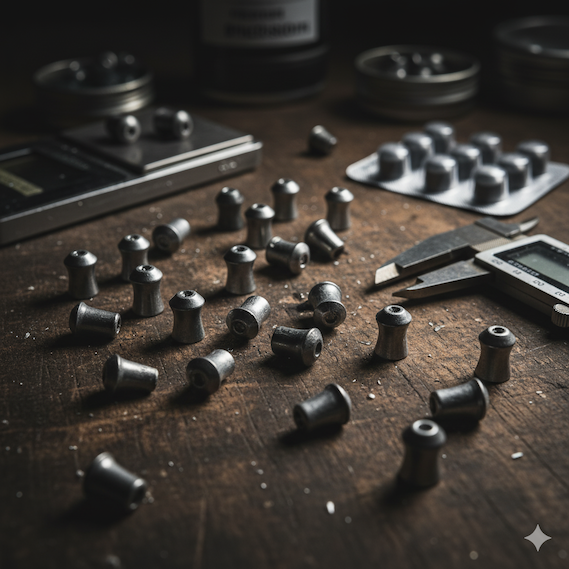
Even perfectly maintained rifles can suffer accuracy problems from pellet-related issues that many shooters overlook. Professional pellet selection goes far beyond choosing a preferred brand, involving systematic testing protocols that reveal subtle but accuracy-critical variations.
Weight consistency testing requires precision scales capable of measuring individual pellets to tenths of grains. A sample of 50-100 pellets should show minimal weight variation – typically less than 0.5 grains for quality pellets. Significant weight variations create different trajectories that manifest as both vertical and horizontal group opening.
Head size measurement importance cannot be overstated for precision shooting. Pellet heads that vary by even 0.001 inches can create different barrel seal characteristics, affecting velocity and accuracy. Professional competitors often sort pellets using pin gauges, keeping only those within extremely tight tolerances for important shooting sessions.
Batch-to-batch variations represent another significant accuracy factor that casual shooters often miss. Manufacturing processes can shift between production runs, creating pellets that look identical but perform differently. Even premium pellet manufacturers can show lot-to-lot variations that affect precision shooting standards.
Storage conditions dramatically impact pellet consistency over time. Exposure to humidity can cause lead oxidation that affects weight and surface characteristics. Temperature cycling can cause dimensional changes in synthetic skirt materials. Professional competitors often maintain controlled storage environments for their precision pellets.
Batch testing procedures involve chronographing representative samples from different manufacturing lots, looking for velocity consistency and accuracy potential. Even pellets from the same manufacturer can show significant lot-to-lot variations that affect precision shooting. Serious competitors often purchase multiple tins from promising lots and conduct extensive testing before committing to large quantities.
Professional Solutions and Restoration Techniques
Addressing the hidden causes of accuracy decline requires systematic approaches that go beyond quick fixes. Professional solutions focus on creating maintenance systems that prevent problems from developing whilst optimising rifle performance for long-term precision.
Precision Maintenance Schedule Development
Developing component-specific maintenance timing requires understanding the wear patterns and service intervals for different rifle systems. Spring-piston rifles typically need comprehensive powerplant service every 10,000-15,000 shots, whilst PCP systems might require valve service at longer intervals but need more frequent seal attention.
Professional maintenance intervals extend beyond manufacturer recommendations, incorporating environmental factors and usage patterns. Rifles used in dusty conditions need more frequent cleaning, whilst those stored in humid environments require enhanced corrosion protection protocols. Competition rifles demand more aggressive maintenance schedules due to their precision requirements.
A performance tracking system allows shooters to identify trends before they become problems. Recording chronograph data, group sizes, and maintenance activities creates a database that reveals patterns invisible to casual observation. Modern shooters often use smartphone apps or simple spreadsheets to maintain detailed records that inform maintenance decisions.
Environmental considerations play a crucial role in maintenance scheduling. Rifles used in coastal environments need more frequent attention due to salt air corrosion, whilst those used in arid conditions might suffer from dust infiltration problems. Professional maintenance schedules account for these environmental factors and adjust service intervals accordingly.
Advanced Restoration Methods
Crown restoration techniques can often salvage damaged muzzles without requiring complete barrel replacement. Professional crown cutting tools can remove damaged material and restore proper gas flow patterns. However, this work requires specialised equipment and considerable skill to avoid making problems worse.
Spring reconditioning involves more than simple replacement, often requiring careful analysis of spring rates, compression characteristics, and compatibility with specific rifle designs. Professional tuners often modify spring dimensions and preload to optimise performance for individual rifles and shooting requirements.
Trigger restoration can transform mediocre mechanisms into precision instruments through careful attention to sear engagement, spring tensions, and surface finishes. Professional trigger work often involves multiple adjustment sessions to achieve optimal performance whilst maintaining safety margins.
Stock bedding restoration requires understanding both traditional techniques and modern materials. Professional bedding work creates consistent, repeatable contact surfaces that maintain accuracy across varying environmental conditions. This work often involves complete stock refinishing to ensure long-term stability.
Implementing Your Accuracy Recovery Plan
Successfully addressing hidden accuracy problems requires a systematic approach that prioritises the most likely causes whilst establishing monitoring systems to prevent future issues. Professional gunsmiths follow established diagnostic protocols that efficiently identify problems without unnecessary disassembly or expense.
Begin your accuracy recovery process with non-invasive diagnostic techniques that don’t require disassembly. Chronograph testing, pellet selection verification, and scope integrity checks can often identify problems without opening the rifle. This approach saves time and avoids creating new problems through unnecessary handling.
Establish baseline measurements for all critical performance parameters before beginning any restoration work. Record velocity consistency, group sizes, trigger pull weights, and any other measurable characteristics. These baselines allow you to track improvement progress and identify which interventions actually improve performance.
Consider professional assistance for complex problems that require specialised tools or experience. Whilst many accuracy issues can be addressed by knowledgeable hobbyists, some problems require professional equipment and expertise to avoid causing additional damage. Establishing relationships with qualified air rifle specialists provides access to advanced diagnostic capabilities when needed.
Conclusion
Maintaining peak air rifle accuracy requires attention to subtle mechanical details that casual maintenance often misses. The seven hidden causes we’ve explored – from breech seal degradation to pellet selection issues – demonstrate why systematic diagnostic approaches outperform reactive maintenance strategies.
The progressive nature of these accuracy killers means that early detection and intervention can often restore peak performance without major expense or extensive work. By understanding the warning signs and implementing professional diagnostic techniques, you can identify problems before they significantly impact your shooting performance.
Regular attention to these often-overlooked areas ensures consistent accuracy and extends your rifle’s competitive lifespan. The investment in proper diagnostic tools and systematic maintenance procedures pays dividends through improved performance and reduced long-term repair costs.
Your next step should involve conducting a comprehensive assessment of your rifle using the diagnostic methods outlined above. Start with the non-invasive techniques that don’t require disassembly, progressing to more detailed investigations only as needed. Whether you choose to tackle these advanced maintenance procedures yourself or seek professional assistance, understanding these hidden accuracy killers empowers you to make informed decisions about your rifle’s care and maintenance.
Remember that accuracy restoration is often a process rather than a single fix. Multiple small improvements can combine to create dramatic performance gains, whilst addressing problems systematically prevents the frustration of chasing symptoms rather than solving root causes.
Check out our articles on:
How to maintain your air pistol
Discover the top 5 air pistol FAQs in the UK
Discover the top 3 glock air pistols
Discover the best spring-powered air pistols
Discover the best PCP air pistols
How to choose your first air pistol
Discover the best air pistol for rats
How to improving air pistol accuracy
Discover the best air pistol scopes and sights

[…] https://www.huntsmansports.com/air-rifle-accuracy-problems-hidden-causes/ […]